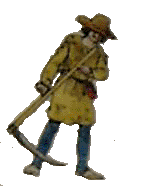| Mention famine
in Ireland and people immediately think of the 1845-47 famine, in
fact there were many periods when the people of Ireland suffered
severe famine conditions, some precipitated by natural disasters
and other the result of warfare and invasion as in 1318 with the
Bruce invasion.
There appears to have been famine conditions
occurring spasmodically in the first half of the eighteenth century.
In 1718 Bishop William Nicolson upon arriving in Derry wrote he
found 'dismal marks of hunger and want' on the faces of the people
in his diocese, a few years later one of his horses was killed in
an accident, he states 'Some fifty people fell on the carcass, hacking
off pieces with choppers and axes to take home for their families'
he also wrote 'We seem to be brought to the brink of a famine, God
defend us from the pestilence.'
Again in 1726-7 food was in short supply
the next year things had not improved, in fact there was a severe
famine in 1728-9. In the winter of 1739 nature conspired to exacerbate
the situation with a severe frost which lasted for seven weeks.
Potatoes in store and in clamps in the fields were destroyed; water-powered
corn mills were totally frozen, and cattle died in the fields. The
river Foyle was frozen and an ox was roasted on the ice. Seeds for
planting were in short supply and further bad weather led to a devastating
famine in 1741 which culminated in the loss of, it is estimated
some 300,000 lives.
A contemporary writer put it thus 'Want and
misery in every face; the rich unable, almost, as they were willing,
to relieve the poor; the roads spread with dead and dying bodies;
mankind the colour of the docks and nettles which they fed on; two
or three, sometimes more, in a car going to the grave for want of
bearers to carry them, and many buried only in the fields and ditches
where they perished.'
The Irish called this bliadhain an áir,
year of the slaughter. |